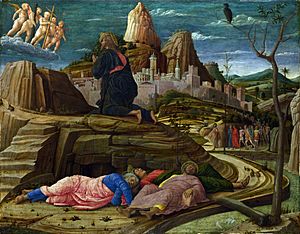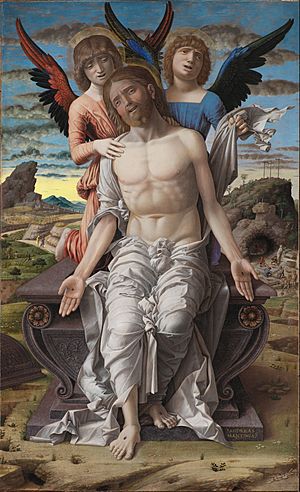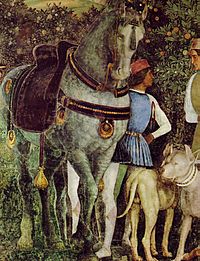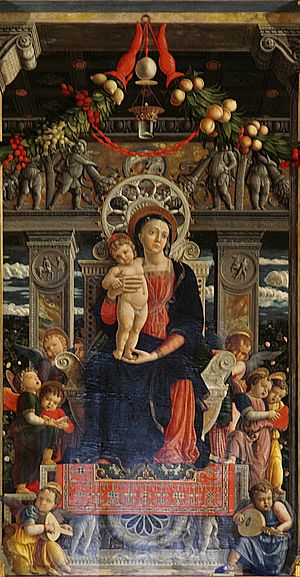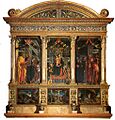Andrea Mantegna facts for kids
Quick facts for kids
Andrea Mantegna
|
|
|---|---|

Bust believed to be by Gian Marco Cavalli
|
|
| Born |
Andrea Mantegna
c. 1431 Isola di Carturo, Venetian Republic (now Italy)
|
| Died | September 13, 1506 (aged 74–75) Mantua (now Italy)
|
| Education | Francesco Squarcione |
| Known for | Painting, fresco |
|
Notable work
|
St. Sebastian Camera degli Sposi The Agony in the Garden |
| Movement | Italian Renaissance |
| Spouse(s) | Nicolosia Bellini |
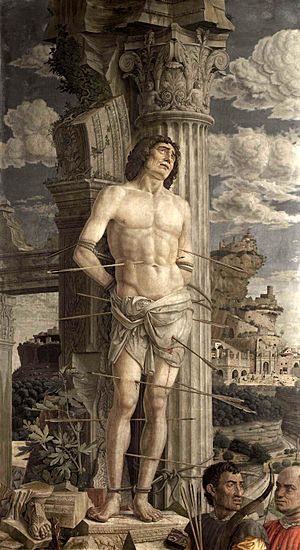
Andrea Mantegna (born around 1431 – September 13, 1506) was a famous Italian painter. He was very interested in the art and history of Ancient Rome. He was also the son-in-law of another well-known artist, Jacopo Bellini.
Like many artists of his time, Mantegna loved to experiment with perspective. This means he played with how objects look smaller or larger depending on their distance. He often made the horizon line very low in his paintings. This made his subjects look grander and more powerful. His paintings often show rocky, metallic landscapes and figures that look almost like stone statues. This shows he thought about painting in a way that was similar to making sculptures. He also ran a workshop that made many prints in Venice before the 1500s.
Contents
Biography
Early Life and Training
Mantegna was born in Isola di Carturo, a small town near Padua in what was then the Venetian Republic (now Italy). His father was a carpenter. When he was just 11 years old, Andrea became an apprentice to a painter named Francesco Squarcione in Padua.
Squarcione, who used to be a tailor, loved ancient art. He traveled around Italy and maybe even Greece, collecting old statues, carvings, and vases. He would draw them himself and then let his students study his collection. Many artists and students came through Squarcione's school, which started around 1440.
Padua was a popular place for artists, even from other parts of Italy like Tuscany. Mantegna's early work was influenced by these artists. Squarcione taught Mantegna Latin and encouraged him to study Roman sculptures. He also liked using forced perspective, which is a way of making things look like they are coming out at you or going far away. This idea influenced Mantegna's later work.
However, when Mantegna was 17, he left Squarcione's workshop. He later said that Squarcione had used his work without paying him enough.
First Major Works
Mantegna's first known painting, which is now lost, was an altarpiece for a church in 1448. In the same year, he joined a group of painters working on the Ovetari Chapel in the Church of the Eremitani. It's thought that Mantegna and other students had already started painting frescoes in another chapel nearby.
After some changes, Mantegna ended up finishing most of the work in the Ovetari Chapel by himself. Squarcione, who was now critical of Mantegna, complained about his early paintings in this series. He said the figures looked like they were made of stone and should have been painted in stone colors.
Sadly, most of these frescoes were destroyed during bombings in 1944. One of the most famous parts was St. James Led to His Execution. This painting used a special "worm's-eye view" perspective, making you feel like you're looking up at the figures from below.
Mantegna also used the style of "wet drapery" from ancient Roman art for the clothes of his figures. This made the fabric look like it was clinging to the body. His figures were often tense and strong, similar to the sculptures of Donatello.
Other early works by Mantegna include two saints painted over the entrance of the church of Sant'Antonio in Padua (1452). He also painted the San Luca Altarpiece (1453), which is now in the Pinacoteca di Brera in Milan. As he grew as an artist, Mantegna was influenced by Jacopo Bellini, who was the father of famous painters Giovanni Bellini and Gentile Bellini. In 1453, Mantegna married Jacopo Bellini's daughter, Nicolosia.
Mantegna's Artistic Style
Mantegna was sometimes criticized because his painted figures looked too much like statues. However, his art actually showed a difference between ancient statues and his own purposeful way of making things look like sculptures. This old criticism came from his teacher, Francesco Squarcione. According to Giorgio Vasari, a famous writer about artists, Squarcione said that Mantegna's figures in the Ovetari Chapel should have been painted like marble, not with colors, because they didn't look alive. This is interesting because Squarcione's love for ancient Roman art was what influenced Mantegna in the first place.
Mantegna learned from his teacher's comments. His later paintings, like those about St. Christopher, still had a sculptural style but also felt more natural and lively. He believed that ancient art was better than nature because it had more perfect forms. Because of this, Mantegna was very precise in his outlines and focused on the figures.
Overall, Mantegna's work often looked strong and serious rather than soft or emotional. His clothes were tightly folded, as if he studied models draped in stiff paper. His figures were slim, muscular, and bony. Their actions were energetic but seemed frozen in time. His landscapes were often dry and rocky, adding to the powerful feel of his art.
Mantegna never really changed his style, but his use of color became stronger over time. He was very good at creating optical illusions, making things look real even if the perspective wasn't always perfectly mathematical. This was amazing for his time.
Work in Mantua
Mantegna left Padua early in his career and never went back. Some say it was because of Squarcione's dislike. He spent the rest of his life in Verona, Mantua, and Rome. In Verona, between 1457 and 1459, he painted a large altarpiece for the church of San Zeno Maggiore. This was one of the first great examples of Renaissance art in Verona.
The Marquis Ludovico III Gonzaga of Mantua had been asking Mantegna to work for him. In 1460, Mantegna became the court artist for the Gonzaga family. He moved to Mantua with his family in 1466. He was paid a very high salary, showing how much his art was valued. He was the first important painter to live in Mantua.
His most famous work in Mantua was painted for the Gonzaga family's palace. It's called the Camera degli Sposi (which means "Wedding Chamber") in the Ducal Palace. This room is covered in frescoes, which are paintings done directly on wet plaster. They include many portraits of the Gonzaga family.
The decoration of the Chamber was probably finished in 1474. The next ten years were difficult for Mantegna. He became easily annoyed, and his son Bernardino died. The Marquis Ludovico, his wife, and his successor also passed away. Things improved when Francesco II of the House of Gonzaga became the new ruler, and art projects started again. Mantegna built a grand house in Mantua, which can still be seen today, though his paintings from it are gone. During this time, he collected ancient Roman busts and finished his intense St. Sebastian painting, now in the Louvre.
In 1488, Pope Innocent VIII asked Mantegna to paint frescoes in a chapel in the Vatican. These frescoes, including a famous Baptism of Christ, were later destroyed. Mantegna also studied ancient Roman buildings in Rome. When he returned to Mantua in 1490, he continued his work on the Triumphs of Caesar. These nine large paintings show the splendor of ancient Roman victories. They are considered some of Mantegna's best works. In 1628, they were sold to King Charles I of England.
Later Years
Even though his health was getting worse, Mantegna kept painting. Other works from this time include the Madonna of the Caves and the famous Lamentation over the Dead Christ. This painting was probably made for his own tomb chapel. Another important work from his later years is the Madonna della Vittoria, now in the Louvre. He painted it around 1495 to celebrate the Battle of Fornovo. The church where this painting was first placed was designed by Mantegna himself.
After 1497, Isabella d'Este, a cultured and intelligent noblewoman, asked Mantegna to paint mythological scenes for her private study in the Ducal Palace. These paintings were later moved to different places. One of them, the legend of the God Comus, was not finished by Mantegna and was completed by another artist.
Mantegna faced some difficulties in his old age, including financial problems. He had to sell a beloved ancient bust to make ends meet. He died in Mantua on September 13, 1506. In 1516, his sons built a beautiful monument for him in the church of Sant'Andrea, where he had painted an altarpiece.
Engravings
Mantegna was also a very skilled engraver. Engraving is a way of making prints by carving a design into a metal plate. His history as an engraver is a bit unclear because he rarely signed or dated his works. It's thought that he and his workshop made about thirty prints. These prints were large, full of figures, and very detailed.
The technique he and his followers used was known for its strong lines and parallel lines to create shadows. The closer the lines were, the darker the shadows appeared. His prints are often found in two "states" or editions. The first ones were made by hand pressing and were lighter. The second ones were made with a printing press and had stronger ink.
It is now believed that neither Mantegna nor his workshop created the famous Mantegna Tarocchi cards.

Painted with tempera on canvas, 68×81 cm, around 1490. It's in the Pinacoteca di Brera, Milan.
Influence and Legacy
Giorgio Vasari, the famous art historian, praised Mantegna, even though he mentioned Mantegna could be difficult. Mantegna was good friends with some of his fellow students from Padua. He sometimes had money problems because he lived an expensive lifestyle.
Mantegna was unmatched in his love for classical art. His influence on Italian art during the 15th century was very strong. Giovanni Bellini, his brother-in-law, clearly followed Mantegna's lead in his early works. The famous German artist Albrecht Dürer was influenced by Mantegna's style during his trips to Italy. Leonardo da Vinci also learned from Mantegna's use of decorations like festoons (hanging garlands of fruit and flowers).
Mantegna's most important contribution is considered to be his use of spatial illusionism. This means making things look like they have depth and space, both in his frescoes and in his religious paintings. His way of decorating ceilings was followed for almost 300 years. Starting with the ceiling of the Camera degli Sposi, artists like Correggio built on Mantegna's ideas about perspective, creating amazing dome paintings like the one in the Cathedral of Parma.
Major Works
- St. Jerome in the Wilderness (c. 1448–1451)
- The Adoration of the Shepherds (c. 1451–1453)
- San Luca Altarpiece (1453)
- St Euphemia (1454)
- Presentation at the Temple (c. 1455)
- Madonna and Child with Saint Jerome and Saint Louis of Toulouse (c. 1455)
- Crucifixion (1457–1459)
- Christ as the Suffering Redeemer (1495–1500)
- Agony in the Garden (c. 1459)
- Portrait of Cardinal Ludovico Trevisan (c. 1459–1460)
- St. Bernardino of Siena between Two Angels (attributed, 1460)
- Portrait of a Man (c. 1460–1470)
- Death of the Virgin (c. 1461)
- Portrait of Francesco Gonzaga (c. 1461)
- Madonna with Sleeping Child (c. 1465–1470)
- St. George (c. 1460)
- San Zeno Altarpiece (1457–1460)
- St. Sebastian (c. 1457–1459)
- St. Sebastian
- Adoration of the Magi (1462)
- The Ascension (1462)
- Portrait of Carlo de' Medici (c. 1459–1466)
- The Madonna of the Cherubim (c. 1485)
- Triumphs of Caesar (c. 1486)
- The Lamentation over the Dead Christ (c. 1490)
- Madonna of the Caves (1489–1490)
- St. Sebastian (1490)
- Madonna della Vittoria (1495)
- Ecce homo (1500)
- Holy Family (c. 1495–1500)
- Judith and Holofernes (1495)
- Trivulzio Madonna (1497)
- Parnassus (Mars and Venus) (1497)
- Minerva Chases the Vices from the Garden of Virtue (c. 1502)
Mantegna's only known sculpture is a Sant'Eufemia in the Cathedral of Irsina, Basilicata.
Images for kids
See also
 In Spanish: Andrea Mantegna para niños
In Spanish: Andrea Mantegna para niños


